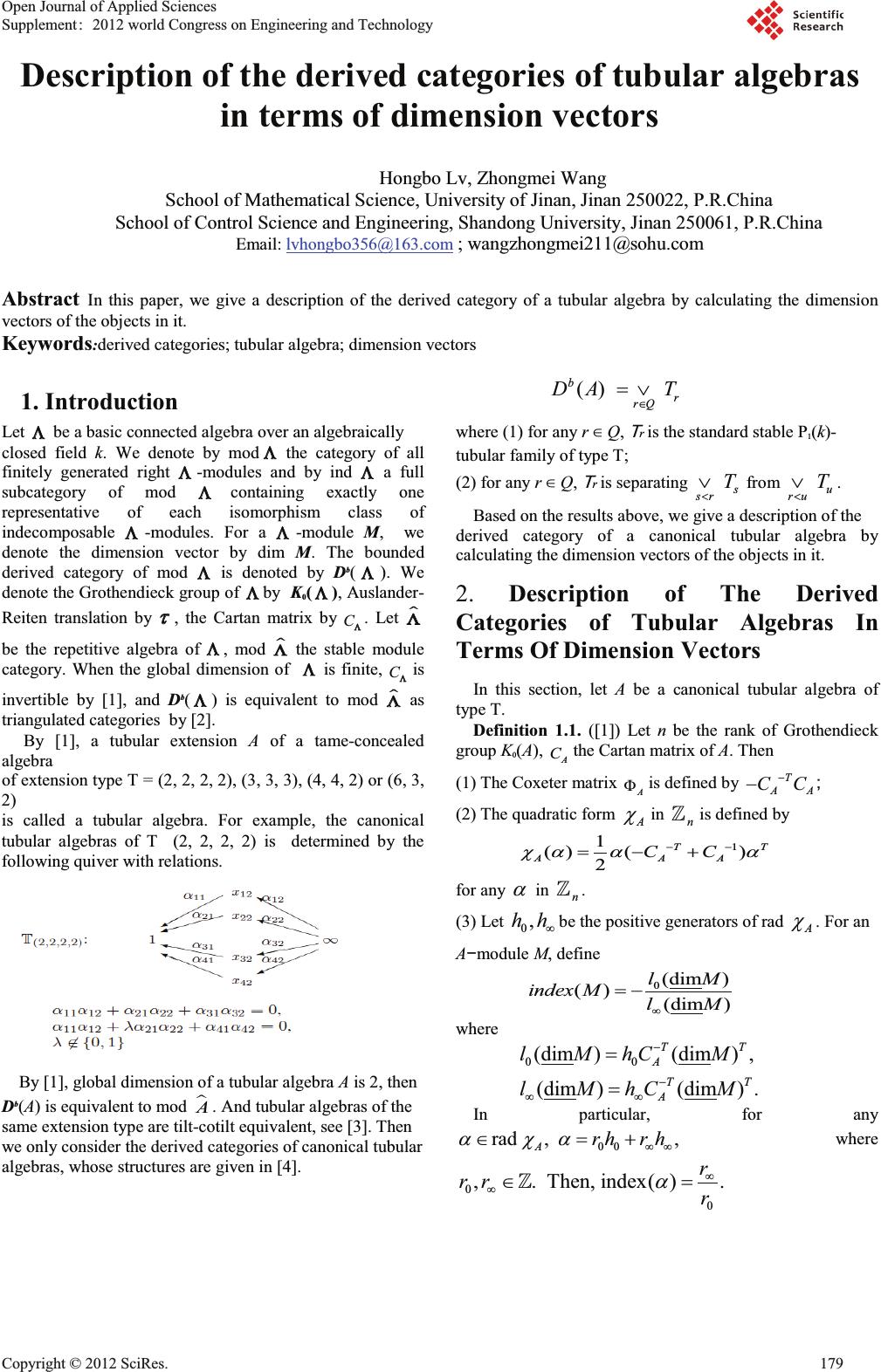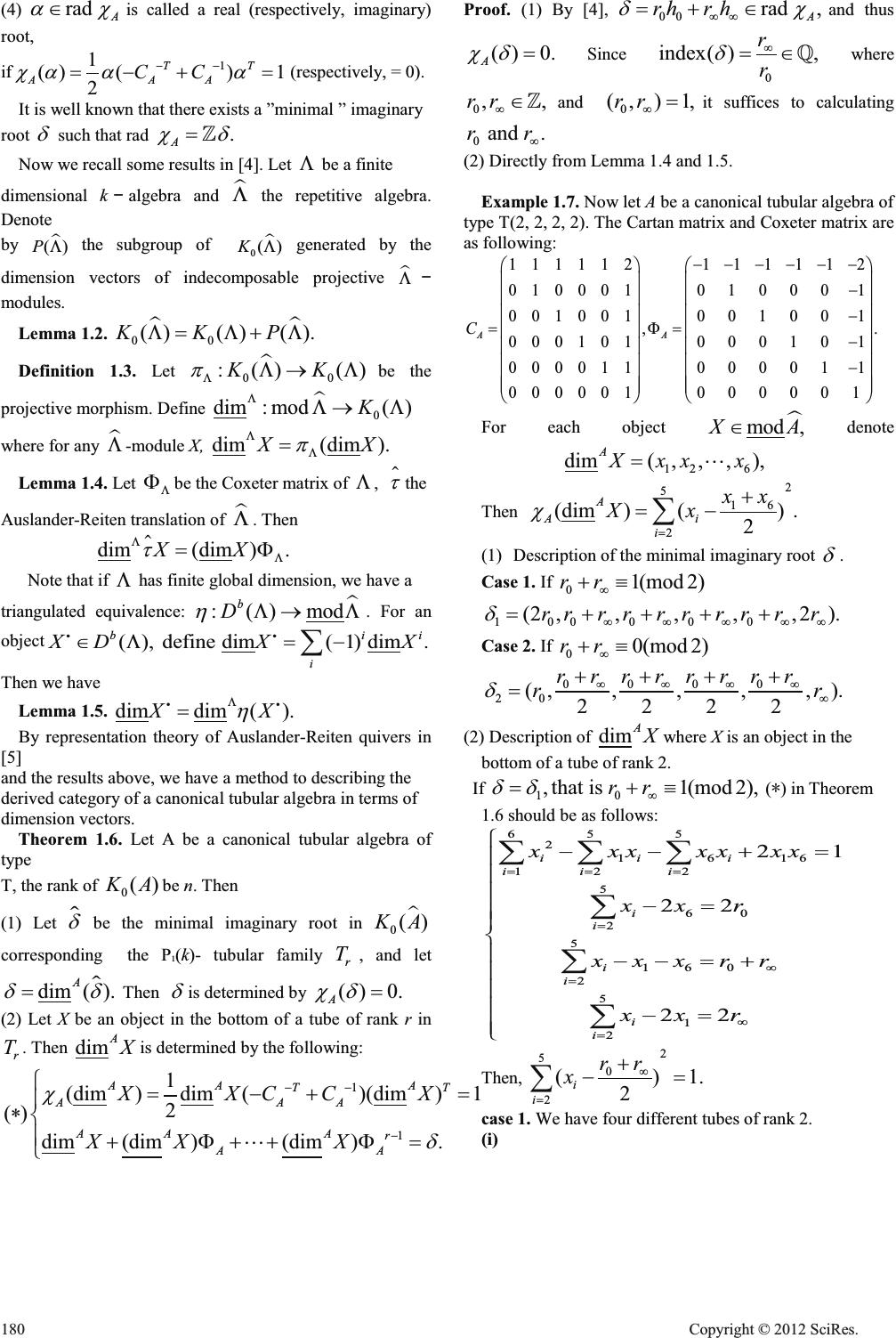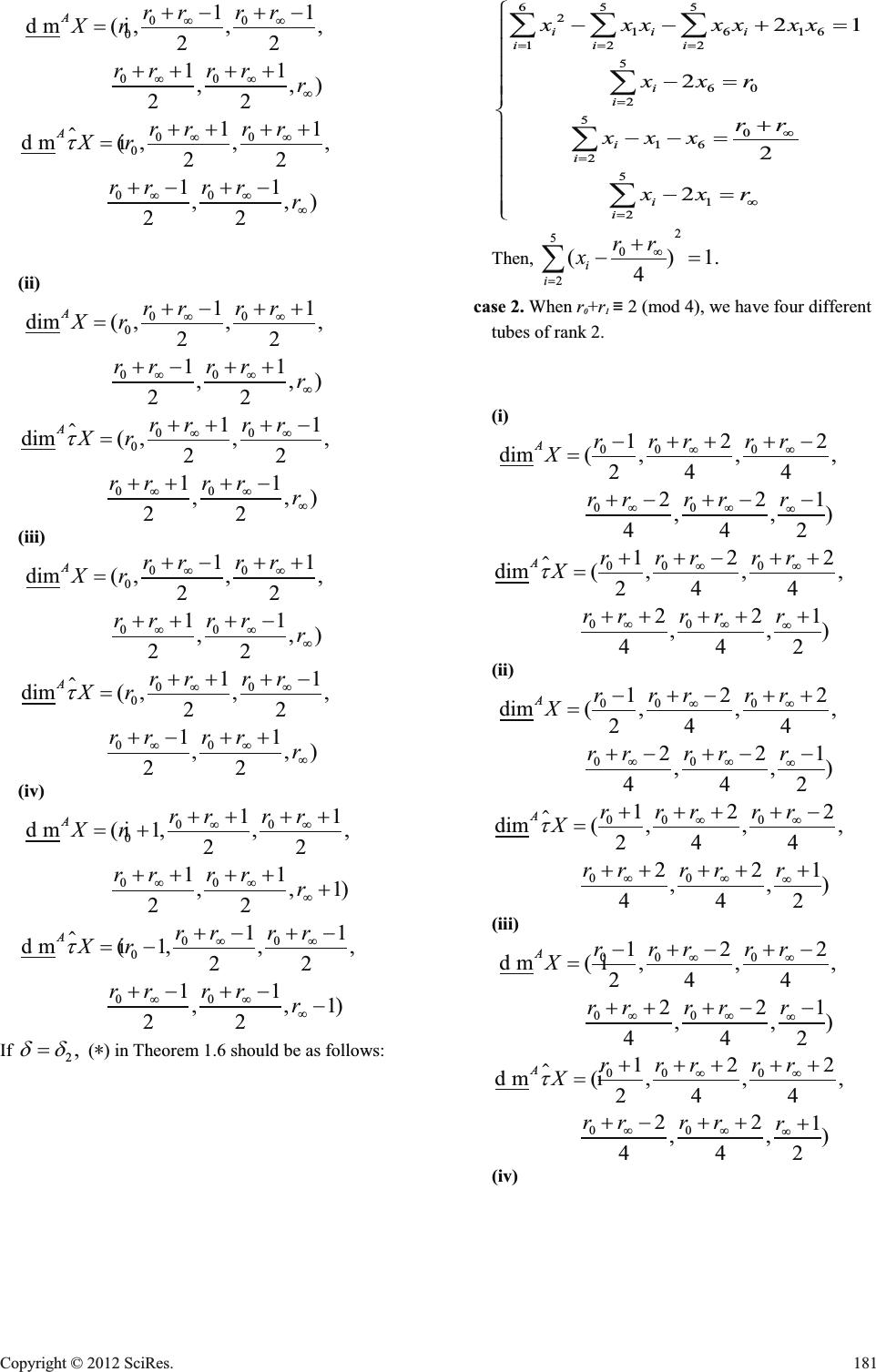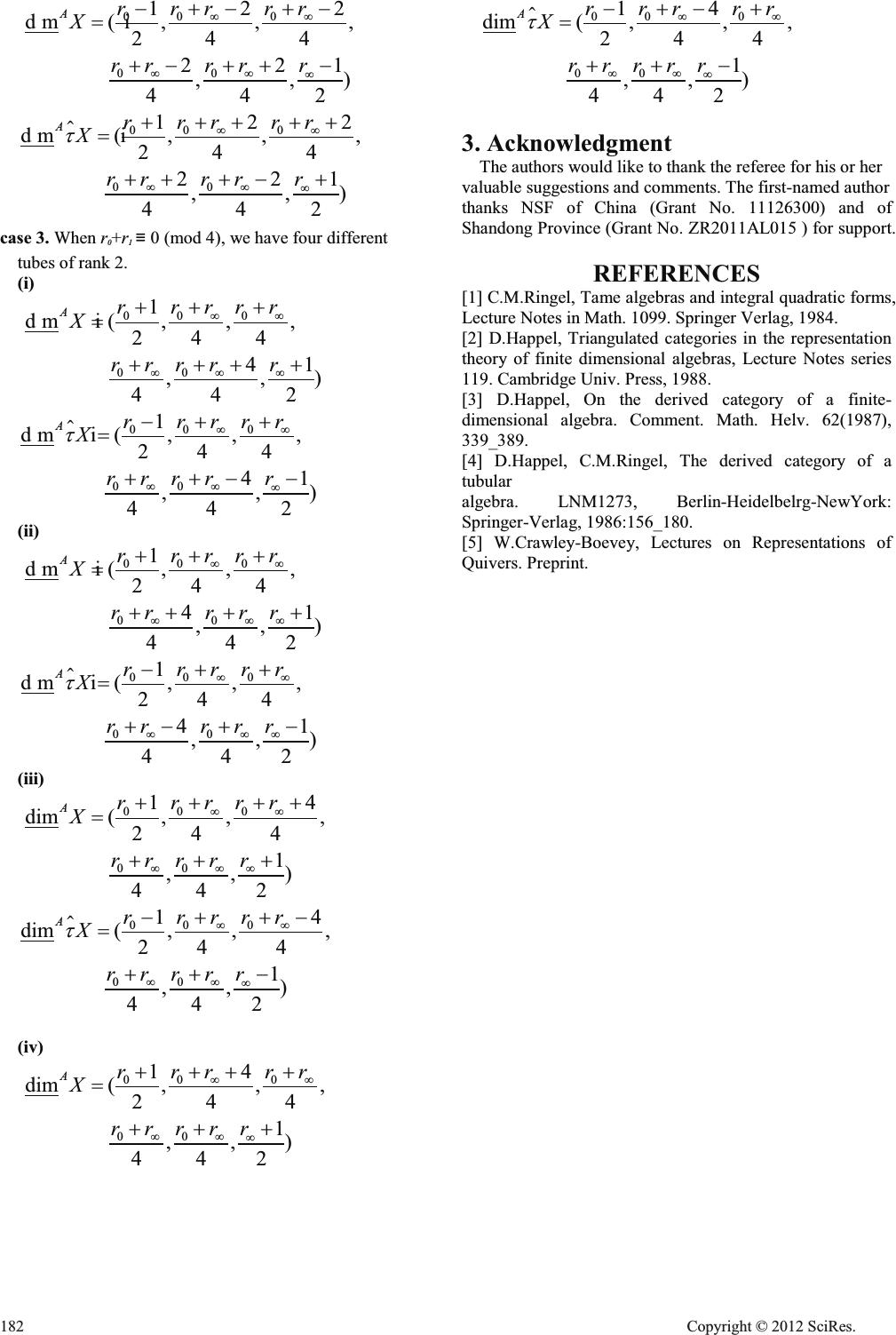Paper Menu >>
Journal Menu >>
 Description of the derived categories of tubular algebras in terms of dimension vectors Hongbo Lv, Zhongmei Wang School of Mathematical Science, University of Jinan, Jinan 250022, P.R.China School of Control Science and Engineering, Shandong University, Jinan 250061, P.R.China Email: lvhongbo356@163.com ; wangzhongmei211@sohu.com Abstract In this paper, we give a description of the derived category of a tubular algebra by calculating the dimension vectors of the objects in it. Keywords:derived categories; tubular algebra; dimension vectors 1. Introduction Let / / be a basic connected algebra over an algebraically closed field k. We denote by mod/ / the category of all finitely generated right / / -modules and by ind / / a full subcategory of mod / / containing exactly one representative of each isomorphism class of indecomposable / / -modules. For a / / -module M, we denote the dimension vector by dim M. The bounded derived category of mod / / is denoted by Db( / / ). We denote the Grothendieck group of / / by K0(/ / ), Auslander- Reiten translation by W W , the Cartan matrix by C / / . Let / / be the repetitive algebra of / / , mod / / the stable module category. When the global dimension of / / is finite, C / / is invertible by [1], and Db( / / ) is equivalent to mod / / as triangulated categories by [2]. By [1], a tubular extension A of a tame-concealed algebra of extension type T = (2, 2, 2, 2), (3, 3, 3), (4, 4, 2) or (6, 3, 2) is called a tubular algebra. For example, the canonical tubular algebras of T (2, 2, 2, 2) is determined by the following quiver with relations. By [1], global dimension of a tubular algebra A is 2, then Db(A) is equivalent to mod l A . And tubular algebras of the same extension type are tilt-cotilt equivalent, see [3]. Then we only consider the derived categories of canonical tubular algebras, whose structures are given in [4]. () b r rQ DA T where (1) for anyrෛ Q, 7 r is the standard stable P1(k)- tubular family of type T; (2) for any r ෛQ, 7 r is separating s sr T from u ruT . Based on the results above, we give a description of the derived category of a canonical tubular algebra by calculating the dimension vectors of the objects in it. 2. Description of The Derived Categories of Tubular Algebras In Terms Of Dimension Vectors In this section, let A be a canonical tubular algebra of type T. Definition 1.1. ([1]) Let n be the rank of Grothendieck group K0(A), A C the Cartan matrix of A. Then (1) The Coxeter matrix A ) is defined by T AA CC (2) The quadratic form A F in n ] is defined by 1 1 () () 2 TT AAA CC FD DD for any D in n ] . (3) Let 0,hh fbe the positive generators of rad A F . For an Amodule M, define 0 (dim ) () (dim ) lM indexMlM f where 00 (dim )(dim ), (dim )(dim ). TT A TT A lMhC M lMhC M ff In particular, for any 00 rad , , Arhr h DFD ff where 0 0 ,. Then, index(). r rr r D f f ] Open Journal of Applied Sciences Supplement:2012 world Congress on Engineering and Technology Cop y ri g ht © 2012 SciRes.179  (4) rad A DF is called a real (respectively, imaginary) root, if 1 1 ()() 1 2 TT AAA CC FD DD (respectively, = 0). It is well known that there exists a ”minimal ” imaginary root G such that rad . A FG ] Now we recall some results in [4]. Let / be a finite dimensional kalgebra and l / the repetitive algebra. Denote by l ()P/ the subgroup of l 0 ()K/ generated by the dimension vectors of indecomposable projective l / modules. Lemma 1.2. ll 00 ()() ().KKP/ // Definition 1.3. Let l 00 :() ()KK S / /o / be the projective morphism. Define l 0 dim: mod()K //o / where for any l / -module X, dim(dim ).XX S / / Lemma 1.4. Let / )be the Coxeter matrix of / , W the Auslander-Reiten translation of l / . Then dim(dim ).XX W / / ) Note that if / has finite global dimension, we have a triangulated equivalence: l :()mod b D K /o / . For an object (), define dim(1)dim. bii i XDX X/ ¦ << Then we have Lemma 1.5. dimdim ().XX K / << By representation theory of Auslander-Reiten quivers in [5] and the results above, we have a method to describing the derived category of a canonical tubular algebra in terms of dimension vectors. Theorem 1.6. Let A be a canonical tubular algebra of type T, the rank of 0()KA be n. Then (1) Let G be the minimal imaginary root in l 0()KA corresponding the P1(k)- tubular family r T, and let dim (). A GG Then G is determined by () 0. A FG (2) Let X be an object in the bottom of a tube of rank r in r T. Then dimAX is determined by the following: 1 1 1 (dim )dim ()(dim )1 2 () dim(dim )(dim ). AA A TT AAA AA A r AA XXCCX XX X F G ° ® °)) ¯" Proof. (1) By [4], 00rad , A rhr h GF ff and thus () 0. A FG Since 0 index( ), r r G f _ where 0,,rr f] and 0 (,) 1,rr f it suffices to calculating 0 and .rr f (2) Directly from Lemma 1.4 and 1.5. Example 1.7. Now let A be a canonical tubular algebra of type T(2, 2, 2, 2). The Cartan matrix and Coxeter matrix are as following: 111112 111112 01000101 0001 0010010 01001 ,. 0001010 00101 000011 00001 1 000001000001 AA C §·§ · ¨¸¨ ¸ ¨¸¨ ¸ ¨¸¨ ¸ ) ¨¸¨ ¸ ¨¸¨ ¸ ¨¸¨ ¸ ¨¸¨ ¸ ¨¸¨ ¸ ©¹© ¹ For each object l mod ,XA denote 12 6 dim( ,,,), AXxx x " Then 2 516 2 (dim)() . 2 A Ai i xx Xx F ¦ (1)Description of the minimal imaginary root G . Case 1. If 01(mod2)rr f { 100000 (2,,,,,2).rr rr rr rr rr G fffff Case 2. If 00(mod 2)rr f { 0000 20 (,,,,,). 2222 rrrrrrrr rr G ffff f (2) Description of dimAX where X is an object in the bottom of a tube of rank 2. If 10 ,that is 1(mod2),rr GG f { (ѽ) in Theorem 1.6 should be as follows: 65 5 2 1616 12 2 5 60 2 5 160 2 5 1 2 21 22 22 iii ii i i i i i i i xxxxxxx xx r xxx rr xxr f f ° ° ° ° ° ® ° ° ° ° ° ¯ ¦¦ ¦ ¦ ¦ ¦ Then, 2 50 2 ()1. 2 i i rr xf ¦ case 1. We have four different tubes of rank 2. (i) 180 Cop y ri g ht © 2012 SciRes.  00 0 00 11 dim(, , , 22 11 ,,) 22 Arr rr Xr rrrr r ff ff f 00 0 00 11 dim(,,, 22 11 ,,) 22 A rr rr Xr rrrr r W ff ff f (ii) 00 0 00 11 dim( ,,, 22 11 ,,) 22 Arr rr Xr rrrr r ff ff f 00 0 00 11 dim(,,, 22 11 ,,) 22 A rr rr Xr rrrr r W ff ff f (iii) 00 0 00 11 dim( ,,, 22 11 ,,) 22 Arr rr Xr rrrr r ff ff f 00 0 00 11 dim(,,, 22 11 ,,) 22 A rr rr Xr rrrr r W ff ff f (iv) 00 0 00 11 dim(1,,, 22 11 ,,1) 22 A rr rr Xr rrrr r ff ff f 00 0 00 11 dim(1,, , 22 11 ,,1) 22 A rr rr Xr rrrr r W ff ff f If 2 , GG (ѽ) in Theorem 1.6 should be as follows: 65 5 2 1616 12 2 5 60 2 50 16 2 5 1 2 21 2 2 2 iii ii i i i i i i i xxxxxxx xxr rr xxx xxr f f ° ° ° ° ° ® ° ° ° ° ° ¯ ¦¦ ¦ ¦ ¦ ¦ Then, 2 50 2 ()1. 4 i i rr xf ¦ case 2. When r0+r1 ิ2 (mod 4), we have four different tubes of rank 2. (i) 00 0 00 122 dim( ,,, 24 4 22 1 ,,) 442 A rrrrr X rr rr r ff ff f 00 0 00 122 dim( ,,, 24 4 22 1 ,,) 442 Arrr rr X rr rr r W ff ff f (ii) 000 00 122 dim( ,,, 24 4 22 1 ,,) 442 A rrr rr X rr rr r ff ff f 00 0 00 122 dim(,,, 24 4 22 1 ,,) 442 A rrr rr X rr rr r W ff ff f (iii) 000 00 122 dim(,,, 24 4 22 1 ,,) 442 A rrr rr X rr rr r ff ff f 00 0 00 122 dim(,,, 24 4 22 1 ,,) 442 Arrr rr X rr rr r W ff ff f (iv) Cop y ri g ht © 2012 SciRes.181  000 00 122 dim(,,, 24 4 22 1 ,,) 442 A rrr rr X rr rr r ff ff f 00 0 00 122 dim(,,, 24 4 22 1 ,,) 442 A rrr rr X rr rr r W ff ff f case 3. When r0+r1 ิ0 (mod 4), we have four different tubes of rank 2. (i) 00 0 00 1 dim(,,, 24 4 41 ,,) 442 A rrrrr X rrrrr ff ff f 00 0 00 1 dim(,,, 244 41 ,,) 442 A rrrrr X rrrrr W ff ff f (ii) 00 0 00 1 dim(,,, 24 4 41 ,,) 442 Arrrrr X rr rr r ff ff f 00 0 00 1 dim(,,, 244 41 ,,) 442 A rrrrr X rr rr r W ff ff f (iii) 00 0 00 14 dim( ,,, 24 4 1 ,,) 442 A rrrrr X rrrr r ff ff f 00 0 00 14 dim( ,,, 24 4 1 ,,) 442 A rrrrr X rrrr r W ff ff f (iv) 00 0 00 14 dim( ,,, 24 4 1 ,,) 442 A rrr rr X rrrr r ff ff f 000 00 14 dim( ,,, 24 4 1 ,,) 442 A rrr rr X rrrr r W ff ff f 3. Acknowledgment The authors would like to thank the referee for his or her valuable suggestions and comments. The first-named author thanks NSF of China (Grant No. 11126300) and of Shandong Province (Grant No. ZR2011AL015 ) for support. REFERENCES [1] C.M.Ringel, Tame algebras and integral quadratic forms, Lecture Notes in Math. 1099. Springer Verlag, 1984. [2] D.Happel, Triangulated categories in the representation theory of finite dimensional algebras, Lecture Notes series 119. Cambridge Univ. Press, 1988. [3] D.Happel, On the derived category of a finite- dimensional algebra. Comment. Math. Helv. 62(1987), 339_389. [4] D.Happel, C.M.Ringel, The derived category of a tubular algebra. LNM1273, Berlin-Heidelbelrg-NewYork: Springer-Verlag, 1986:156_180. [5] W.Crawley-Boevey, Lectures on Representations of Quivers. Preprint. 182 Cop y ri g ht © 2012 SciRes. |

